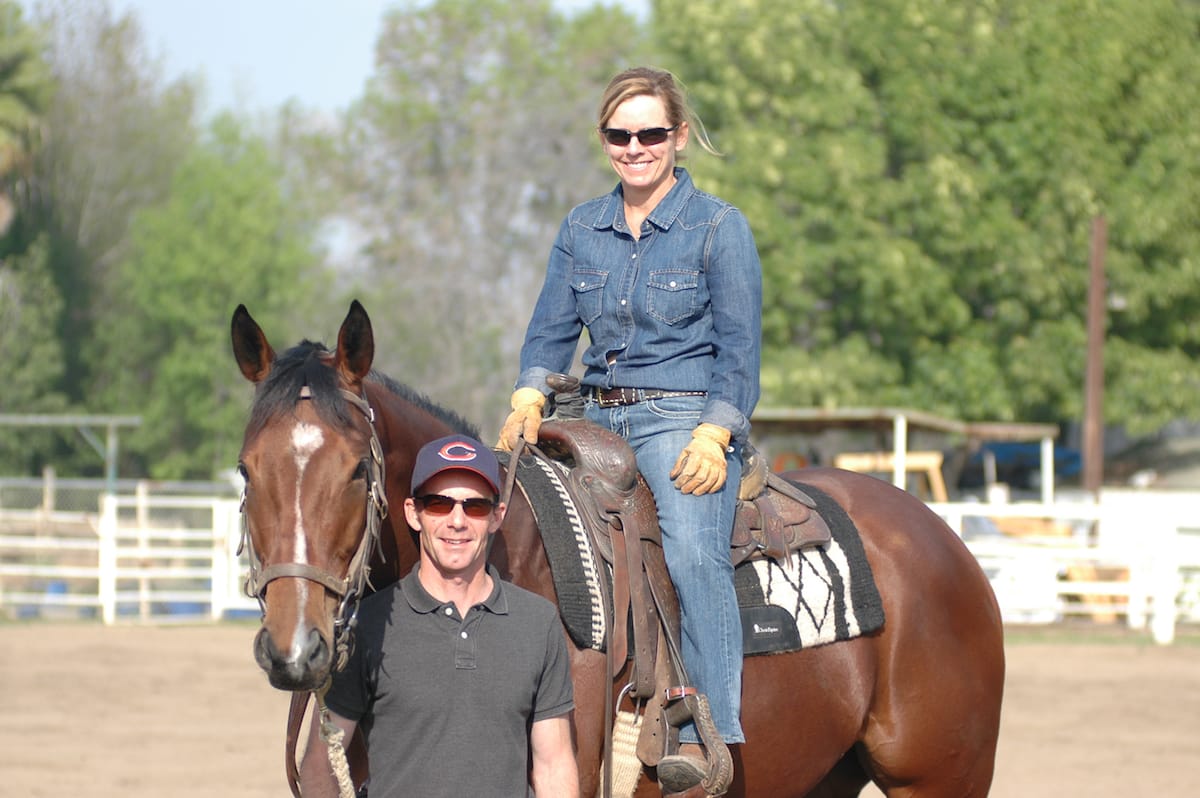Getting a gangly yearling sale-ready is an art that sets the horse up for a lifetime of good manners.

Julie Adair Stack and her husband run a layup facility and prep sale horses in California. Courtesy Tracy Gantz
Ground manners are something we reinforce in our horses constantly. A polite horse won’t invade your space or pull back when you lead him. If you’re lucky he’ll avoid stepping on your toes, as well, especially on that one day you opt to don those old running shoes rather than paddock boots at the barn.
Off-track Thoroughbreds need plenty of training for whatever their second careers may be, but most come with excellent ground manners. Racehorses receive daily etiquette training during barn routines, and this starts as early as a few months of age if they’re to go through a public auction.
Racehorses can encounter sale rings often during their careers, but one of the most common spots is at a yearling auction. At these sales buyers can see how horses are built and get a glimpse of their potential athleticism by their walk. Sellers want to show off both these qualities, and to do that the horse must stand square and walk docilely and well.
Julie Adair Stack preps her own sale horses annually as well as clients’ horses. She and her husband, former jockey and current exercise rider John Stack, run a layup facility not far from Santa Anita Park, in Southern California. They frequently give multiple champion Beholder, as well as several other major racehorses, a place to get a little R&R.
For years, Julie worked as a stunt double in movies. She doubled Drew Barrymore in “Bad Girls,” and her career included “The Horse Whisperer,” “Flicka” and “Dreamer.”
The daughter of the late great Quarter Horse jockey Bobby Adair, Julie also has transitioned racehorses into second careers. Champion sprinter Kona Gold became a stable pony after Julie taught him his new job. Julie and John’s current pony at their barn is a former Quarter Horse racer named The Miner, and they are making a pony out of the Thoroughbred Setsuko, who earned $659,436 on the track.
Developing Without Overdoing
Julie works hard to get young horses ready for sales. It’s an art because these animals are still growing, sometimes in spurts. Yearlings must look athletic to attract buyers, but sales prep shouldn’t be overdone such that it compromises horses’ development.
“Sales prep should start from the time they are born,” says Julie. “You need to start with nutrition from Day 1 with a sale in mind.”
A good nutrition program aids in a young horse’s development, which helps him not only prepare for sale but also grow into an athlete.
“If the sale doesn’t work out, you’ve lost nothing,” says Julie.
Many Thoroughbred breeders pay close attention to nutrition. They want to balance feeding young horses properly to support their growth with avoiding the problems of overfeeding. Too much grain, for example, can lead to overly rapid growth and conditions such as osteochondritis dissecans (OCD), a bone and joint developmental disease.
It’s Never Too Early to Start
Farms that send many horses to sale extend that idea of starting sales prep from birth to early halter and leading lessons, as well as regular hoof trimming and grooming. Sale agents do, however, get their share of wild youngsters that haven’t had the proper foundation, making their jobs much more difficult.
“Some people use a 60-day crash course right before a sale,” says Julie. “I don’t think that is the ideal way to bring them along.”
Still, that’s where a yearling sale can help. Better for the wild ones to start as weanlings or young yearlings receiving training in manners for a sale than waiting. If they don’t go to a yearling sale, they might remain in a pasture without training until time to start them under saddle for their racing debut at 2 or even 3. A horse that comes with ground manners will usually take to advanced lessons much easier.
“You have to be teaching them at all times so that they don’t feel like you have sessions where you are picking at them,” says Julie. “It should just be that whenever you have a hold of them you are teaching them the proper way to stand up and place their feet. It’s a daily thing.”
Appearance Is Everything
Foot placement is critical to showing a sale horse. Thoroughbred sellers prize the classic conformation pose, with the front and back legs closest to the camera straight underneath the horse and the opposite foreleg slightly behind and the opposite hind slightly in front. The horse should stand pleasantly and quietly. It is a lot to ask of a young horse.
“It’s very important that they stand really well-balanced, with some poise, and relaxed and calm,” says Julie.
Fitness plays a crucial role. Fit yearlings’ conformation and potential racing ability are more apparent than those of unfit yearlings, and they also have the stamina to endure constant showing at the sale grounds.
“Most of the time I pony them,” says Julie of her fitness-building regimen, “which is pretty labor-intensive because you’re jogging every single step with them (rather than relying on an automatic walker). But in my opinion you really get optimal results in fitness and manners.”
She likes to change up the routine so young horses don’t get bored. She also works with them on the ground in her round pen.
“Sometimes I’ll get them as far along as ground-driving them,” Julie says, “especially if a particular horse needs it for behavior and manners.”
She occasionally hauls individuals to a facility that has a swimming pool. Swimming can take pressure off the joints while still getting the youngster fit.
“I might do that if I’m having trouble getting weight off of them,” she says. “You don’t want to do that much jogging with a horse that is heavy.”
Other facilities might use treadmills or automatic walkers. Turnout time can also help build fitness, though as the sale approaches managers keep the yearlings inside more to maintain their coats and feet. Anyone who has ever fitted halter horses knows the importance of overall appearance, down to a good body clip and neat noses, ears and fetlocks.
Julie teaches sale horses to walk properly, often using her body language.
“When I’m walking to and from the barn or whenever I’m hand-walking them, I’m always encouraging them to walk out,” she says. “You’re looking for that nice, lengthy walk with a little bit of an overstep.”
Julie stands near the horse’s shoulder rather than out in front of the animal. She encourages the horse to go first, before the handler.
“It’s all about making the right thing easy and the wrong thing hard,” she says.
Manners and fitness prepare yearlings for other facets of the sale. Sellers must haul their horses to the sale grounds, a trip that can be made in anything from a single-horse trailer to a huge multi-horse van.
Once on the grounds, the yearlings might have to undergo veterinary exams, including X-rays and endoscopies. They must be willing to be handled by several grooms, especially when in the hands of sellers with a large horse contingent.
“I like to think that everything I’m doing with a horse is setting them up for success in whatever they’re going to do,” says Julie. “I feel a lot of satisfaction if I’m setting horses up to be as successful as they can be, whether it’s racing or saddle horse or showing.”
If the people who prep and sell the yearling do their jobs properly, those lessons will last a lifetime.
This article was originally published in the Fall 2016 issue of Off-Track Thoroughbred Magazine, the only publication dedicated to the Thoroughbred ex-racehorse in second careers. Want four information-packed issues a year delivered to your door or your favorite digital device? Subscribe now!

